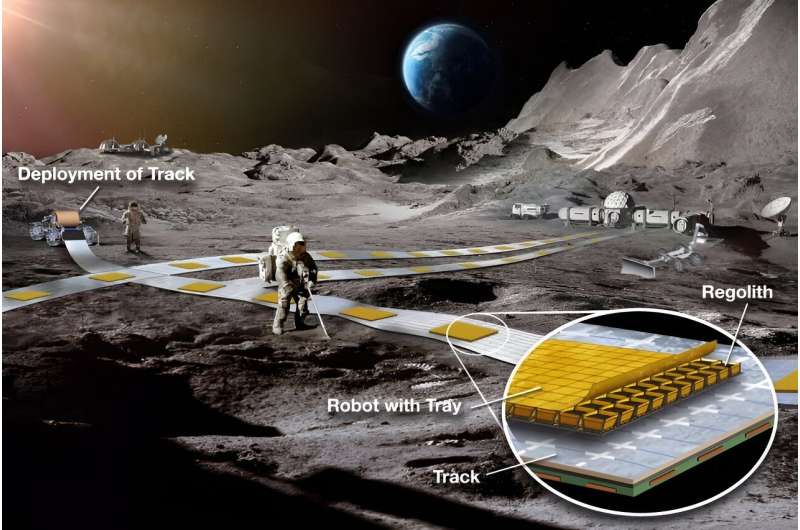This article has been reviewed according to Science X's editorial process and policies. Editors have highlighted the following attributes while ensuring the content's credibility:
fact-checked
trusted source
proofread
A maglev system on the moon could make lunar logistics a breeze

Maglevs are one of those technologies that still look like magic, even years after they were initially rolled out. While they have long been a workhorse of the transportation systems of some major cities, they don't often impact the day-to-day lives of people who don't use them to commute. But, they might be invaluable in another setting—lunar exploration. There's an ongoing debate about the best way to shuttle stuff around on the moon's surface, and a team from JPL and a company called SRI International think they have a solution—deploy a maglev track on the moon.
The project, known as the Flexible Levitation on a Track (FLOAT) system, is simple in concept. It is based on a concept developed at SRI that showcases the ability to float small robots over a platform and precisely control their movements using a form of magnetic levitation. Scale-wise, as seen in the video below, the technology so far is still small. However, the FLOAT team received a NASA Institute for Advanced Concepts (NIAC) grant to research how scaling up the technology would work on the moon.
Arguably the most crucial part of the technology is the track. It consists of two necessary and a third optional layer. The base layer is graphite, allowing robots to use a force called diamagnetic levitation to float above the track. A second layer is a series of circuits that control the magnetic fields around the track, allowing users to push or stop carts that are moving along it. The optional third layer is a series of solar panels that can collect solar energy while daylight is on that side of the moon.
An important point is that the carts don't have to have any brains themselves. The power and control for the carts both come from the track itself—there are no batteries, logic, or anything else on the carts themselves. That lessens the actual cart's weight, allowing it to have more carrying capacity.
Another exciting idea described in the team's final report is that the FLOAT track can be manufactured in a facility and then deployed by a rover by deploying it out of a spool. The materials the track is made out of are flexible, making the spool an ideal deployment methodology and significantly decreasing the cost, especially compared to typical road building here on Earth.
Another advantage of the FLOAT system is that it won't kick up any dust once it is laid out—which is potentially one of the most dangerous parts of lunar exploration. The team's calculations suggest they could levitate the carts more than twice the height of a typical lunar dust particle, allowing them to move down the track without disturbing any dust already on it. Unlike on Earth, there is no air on the Lunar Surface, so large levitating carts won't disturb the dust to either side of the track as they pass by.
However, there is a chance that some dust would settle on the track, especially when it is first deployed or if other activities are happening in the vicinity (like ice mining). If that does happen, the FLOAT system could use a specially designed cart with a broom attached to the front of it to sweep the dust off the track before regular carts continue their operation on it.
Even hills don't seem to be much of a problem—calculations in the final paper show that carts could move at reasonable speeds both up and down 30% grades without requiring too much power. That ability could significantly increase the areas that the track could cover and allow for even more sites to be connected to the FLOAT network.
Connectivity is the name of the game here, as the spooling technology would allow tracks to be deployed to any number of sites, whether economic, scientific, or logistical. However, one of the major problems facing the scaling up of the technology is how to tie all those spokes together. Connecting two parts of the floating track remains a challenge and one that will be key to solving if the technology is ever to be adopted.
That adoption is probably still far off, as the Artemis missions that would start building the lunar infrastructure that would need such a system are still years away. The team points out that they could have a working system up and running by the mid-2030s—right around the time a permanent lunar base will be operational. But for now, it's unclear what the project's future is—there aren't any publicly available funding sources of note right now. However, there is undoubtedly a need for a robust transportation system on the moon when we establish a permanent presence there—and maybe a future version of FLOAT will provide that.
More information: FLOAT—Flexible Levitation on a Track: www.nasa.gov/sites/default/fil … ler_float_tagged.pdf
Provided by Universe Today




















